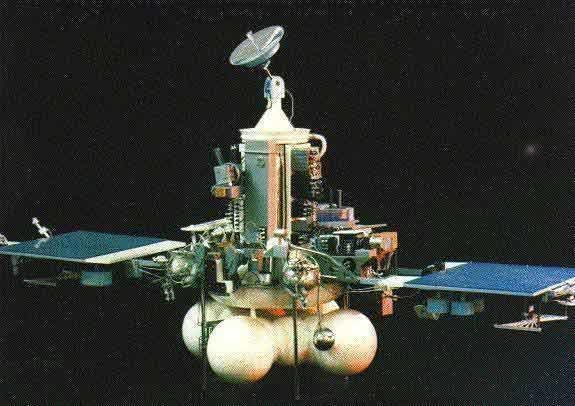Operator IKI SATCAT no. 19281 Rocket Proton-K 8K82K/D-1 Launch mass 6,220 kg | COSPAR ID 1988-058A Epoch planned Launch date 7 July 1988 | |
 | ||
Phobos 1 was an unmanned Russian space probe of the Phobos Program launched from the Baikonour launch facility on 7 July 1988. Its intended mission was to explore Mars and its moons Phobos and Deimos. The mission failed on 2 September 1988 when a computer malfunction caused the end-of-mission order to be transmitted to the spacecraft. At the time of launch it was the heaviest interplanetary spacecraft ever launched, weighing in at 6,200 kg.
Contents
Flight Plan
It was to take an estimated 200 days for the Phobos 1 space probe to travel from the Earth to Mars. Two mid-course corrections were planned. The first between days 7 and 20, and the second between day 185 and 193. These corrections would place the probe in a highly elliptical orbit around Mars. Next, it was to move into an almost circular observation orbit at 350 km. After achieving observation orbit the lower stage of the propulsion system would be dropped. The probe would then rendezvous with Phobos; drop a lander containing scientific equipment from an altitude of 50 meters, and move into a final equatorial orbit above Mars where it would study the martian surface and atmosphere.
Mission Objectives
The Phobos 1 probe's scientific study was separated into three phases. In stage one the probe would investigate the Sun and interplanetary space while traveling from the Earth to Mars. In stage two the probe would study Mars and Phobos while in orbit around Mars. During the final stage it would approach to within 50 meters of the Phobos surface while conducting several experiments.
Experiments
The Phobos probe carried several scientific experiments. It carried a radar transmitter, X-ray and alpha-backscatter spectrometers, camera, and a laser that could vaporize tiny spots so a reflector could analyze the vapor for atomic masses.
The probe also carried a "hopper". The hopper would be dropped onto Phobos to drill and analyze the soil. It would be able to bounce across the terrain by using spring loaded legs.
Computer Malfunction
On September 2, a faulty key-command was sent up to Phobos 1 from ground control in Yevapatoria. A technician unintentionally left out a single hyphen in one of the keyed commands. All commands were supposed to be proofread by a computer before being transmitted, but the computer that checked code was malfunctioning. The technician violated procedure and transmitted the command before the computer could be fixed to proofread it. This minor alteration in code caused the end-of-mission command to reach the spacecraft; shutting down all of the systems aboard Phobos 1.
The error is also contributed to a political arguments between Yevapatoria and Moscow over who should control the mission. Moscow won control responsibility, but Yevapatoria would be responsible for checking all transmitted commands. This further complicated the process of transmitting valid commands to the spacecraft.
Subsequent Investigation
After the incident at Yevapatoria, an investigation was immediately ordered to determine who was responsible for the failure. Nevertheless, disciplinary action was postponed until the completion of the Phobos 2 mission. This was to prevent the demoralization of the Phobos 2 team. Any penalization of the Phobos 1 team would create anxiety among the Phobos 2 team and reduce the chances of mission success. This postponement of punitive measures was urged by IKI director Roald Sagdeev. He quoted secret service chief Lavrentin Beria saying "Let's make them work for now. We can shoot them all later." The investigation concluded with the dismissal of the ground control commander at Yevapatoria and the acknowledgement that the computer system was badly designed.
Legacy
Phobos 1 failed before it could achieve its main scientific objectives, and while the Phobos Program as a whole can be considered a failure. The probes discovered previously unknown information concerning Mars and Phobos during their lengthy orbital flights. In 1988, less was known about Mars and its satellites than the more distant gas giants.
